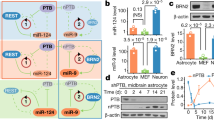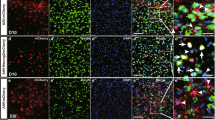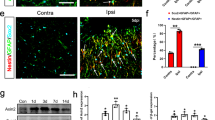Abstract
The conversion of non-neuronal cells to neurons is a promising potential strategy for the treatment of neurodegenerative diseases. Recent studies have reported that shRNA-, CasRx-, or ASO-mediated Ptbp1 suppression could reprogram resident astrocytes to neurons. However, some groups have disputed the interpretation of the data underlying the reported neuron conversion events. These controversies surrounding neuron conversion may be due to differences in the astrocyte fate-mapping systems. Here, we suppressed Ptbp1 using Cas13X and labelled astrocytes with an HA tag fused to Cas13X (Cas13X-NLS-HA). We found no astrocyte-to-neuron conversion in the mouse striatum via the HA-tagged labelling system compared with the GFAP-driven tdTomato labelling system (AAV-GFAP::tdTomato-WPRE) used in previous studies. Our findings indicate that Cas13X-mediated Ptbp1 knockdown failed to induce neuron conversion in vivo.
This is a preview of subscription content, access via your institution
Access options
Subscribe to this journal
Receive 12 print issues and online access
$259.00 per year
only $21.58 per issue
Buy this article
- Purchase on Springer Link
- Instant access to full article PDF
Prices may be subject to local taxes which are calculated during checkout



Similar content being viewed by others
References
Heins N, Malatesta P, Cecconi F, Nakafuku M, Tucker KL, Hack MA, et al. Glial cells generate neurons: the role of the transcription factor Pax6. Nat Neurosci. 2002;5:308–15.
Xue Y, Ouyang K, Huang J, Zhou Y, Ouyang H, Li H, et al. Direct conversion of fibroblasts to neurons by reprogramming PTB-regulated microRNA circuits. Cell. 2013;152:82–96.
Qian H, Kang X, Hu J, Zhang D, Liang Z, Meng F, et al. Reversing a model of Parkinson’s disease with in situ converted nigral neurons. Nature. 2020;582:550–6.
Zhou H, Su J, Hu X, Zhou C, Li H, Chen Z, et al. Glia-to-neuron conversion by CRISPR-CasRx alleviates symptoms of neurological disease in mice. Cell. 2020;181:590–603.e16.
Maimon R, Chillon-Marinas C, Snethlage CE, Singhal SM, McAlonis-Downes M, Ling K, et al. Therapeutically viable generation of neurons with antisense oligonucleotide suppression of PTB. Nat. Neurosci. 2021;24:1089–99.
Wang LL, Serrano C, Zhong X, Ma S, Zou Y, Zhang CL. Revisiting astrocyte to neuron conversion with lineage tracing in vivo. Cell. 2021;184:5465–81.e16.
Xie Y, Zhou J, Chen B. Critical examination of Ptbp1-mediated glia-to-neuron conversion in the mouse retina. Cell Rep. 2022;39:110960.
Chen W, Zheng Q, Huang Q, Ma S, Li M. Repressing PTBP1 fails to convert reactive astrocytes to dopaminergic neurons in a 6-hydroxydopamine mouse model of Parkinson’s disease. eLife. 2022;11:e75636.
Hoang T, Kim DW, Appel H, Pannullo NA, Leavey P, Ozawa M, et al. Genetic loss of function of Ptbp1 does not induce glia-to-neuron conversion in retina. Cell Rep. 2022;39:110849.
Leib D, Chen YH, Monteys AM, Davidson BL. Limited astrocyte-to-neuron conversion in the mouse brain using NeuroD1 overexpression. Mol Ther J Am Soc Gene Ther. 2022;30:982–6.
Chan KY, Jang MJ, Yoo BB, Greenbaum A, Ravi N, Wu WL, et al. Engineered AAVs for efficient noninvasive gene delivery to the central and peripheral nervous systems. Nat. Neurosci. 2017;20:1172–9.
Xu C, Zhou Y, Xiao Q, He B, Geng G, Wang Z, et al. Programmable RNA editing with compact CRISPR-Cas13 systems from uncultivated microbes. Nat. Methods. 2021;18:499–506.
Lee Y, Messing A, Su M, Brenner M. GFAP promoter elements required for region-specific and astrocyte-specific expression. Glia. 2008;56:481–93.
He B, Peng W, Huang J, Zhang H, Zhou Y, Yang X, et al. Modulation of metabolic functions through Cas13d-mediated gene knockdown in liver. Protein Cell. 2020;11:518–24.
Zhou C, Hu X, Tang C, Liu W, Wang S, Zhou Y, et al. CasRx-mediated RNA targeting prevents choroidal neovascularization in a mouse model of age-related macular degeneration. Natl Sci Rev. 2020;7:835–7.
Powell JE, Lim CKW, Krishnan R, McCallister TX, Saporito-Magrina C, Zeballos MA, et al. Targeted gene silencing in the nervous system with CRISPR-Cas13. Sci Adv. 2022;8:eabk2485.
Tong H, Huang J, Xiao Q, He B, Dong X, Liu Y, et al. High-fidelity Cas13 variants for targeted RNA degradation with minimal collateral effects. Nat. Biotechnol. 2023;41:108–19.
Gao Y, Fang K, Yan Z, Zhang H, Geng G, Wu W, et al. Develop an efficient and specific AAV-based labeling system for Muller glia in mice. Sci Rep. 2022;12:22410.
Vuong JK, Lin CH, Zhang M, Chen L, Black DL, Zheng S. PTBP1 and PTBP2 serve both specific and redundant functions in neuronal Pre-mRNA Splicing. Cell Rep. 2016;17:2766–75.
Yang RY, Chai R, Pan JY, Bao JY, Xia PH, Wang YK, et al. Knockdown of polypyrimidine tract binding protein facilitates motor function recovery after spinal cord injury. Neural Regen Res. 2023;18:396–403.
Acknowledgements
We thank Weiya Bai and Guannan Geng for AAV vector preparation, Yanxia Gao and Leping Cheng for project discussion.
Funding
This work was supported by National Science and Technology Innovation 2030 Major Program (2021ZD0200900); Lingang Laboratory (LG202106-01-02); Strategic Priority Research Program of Chinese Academy of Sciences (XDB32060000); National Natural Science Foundation of China (31925016, 82021001); Basic Frontier Scientific Research Program of Chinese Academy of Sciences From 0 to 1 original innovation project (ZDBS-LY-SM001); Shanghai Municipal Science and Technology Major Project (2018SHZDZX05); Project of Shanghai Municipal Science and Technology Commission (20MC1920400).
Author information
Authors and Affiliations
Contributions
LS, HY, and KF designed the research, GY, ZY, XW, and MZ performed experiments and analyzed data. CX, HY, and KF wrote the manuscript with input from all authors.
Corresponding authors
Ethics declarations
Competing interests
HY and LS are co-founders of HuiGene Therapeutics Co., Ltd. GY, XW and MZ are employees of HuiGene Therapeutics Co. The remaining authors declare no conflict of interest.
Ethical approval
This study was approved by Animal Care and Use Committee of the Institute of Huigene Therapeutics Inc., Shanghai, China. All the procedure was performed with sterile, clinical-grade surgical instruments and by experienced technicians.
Additional information
Publisher’s note Springer Nature remains neutral with regard to jurisdictional claims in published maps and institutional affiliations.
Supplementary information
Rights and permissions
Springer Nature or its licensor (e.g. a society or other partner) holds exclusive rights to this article under a publishing agreement with the author(s) or other rightsholder(s); author self-archiving of the accepted manuscript version of this article is solely governed by the terms of such publishing agreement and applicable law.
About this article
Cite this article
Yang, G., Yan, Z., Wu, X. et al. Ptbp1 knockdown failed to induce astrocytes to neurons in vivo. Gene Ther 30, 801–806 (2023). https://doi.org/10.1038/s41434-023-00382-5
Received:
Revised:
Accepted:
Published:
Issue Date:
DOI: https://doi.org/10.1038/s41434-023-00382-5



